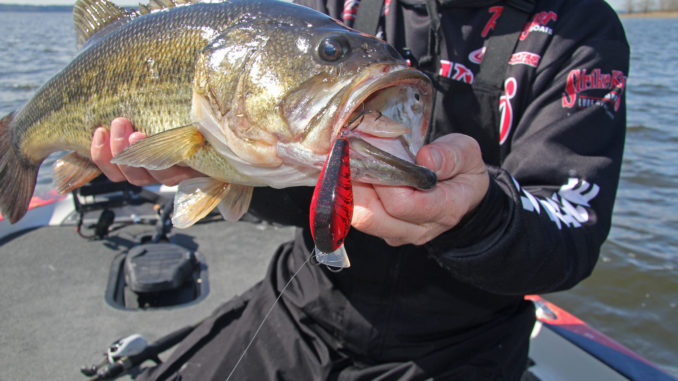
Square-billed crankbaits, jigs, jerkbaits are weapons for Lake Norman’s early bass.
February is the month marked by Valentine’s Day, and it’s when bass pro Bryan Thrift of Shelby loves Lake Norman. But it’s not a roses and chocolates thing; rather, the second month of the year offers a tremendous opportunity to catch some of the biggest bags of bass of any time.
This is prespawn time. Big, ripe females with bulging bellies are preparing for their shallow move, but first, they’ll undertake a serious feeding binge.
“This is one of the best times of the year to catch a big bag of fish on Lake Norman,” said Thrift, a past Angler of the Year on the FLW Tour. “Usually, this time of year, the fish are a lot fatter and healthier. Some of the biggest bags I’ve seen on Norman have come in February.
“Most of the fish will be in a prespawn mode. They’re going to be staging up and getting ready to spawn. They’ll actually be some fish spawning in late February around the mouth of both power plants where the water’s a little warmer.”
Typical prespawn strategy finds bass setting up shop on the last piece of structure before they get to their spawning grounds. Contour breaks, rocky points, stump fields; they all fit the bill in various settings. But on this highly developed Catawba River impoundment, the two dominant scenarios are docks and rocks. Here’s a snapshot of prespawn tactics for both.
“Most of the fish at Norman will stage on boat docks,” Thrift said. “You’ll have docks that are loaded with brush and stuff that people have put out (for crappie), and that’s where the fish will position.”
The second choice for prespawn Norman bass, according to pro fisherman Andy Montgomery of Blacksburg, S.C., is riprap. Norman’s vast development offers plenty of the man-made embankments, but he’ll look closely to identify areas interspersed with natural rock, which typically bring spikes in opportunity.
Thrift points out that water color plays a key role in daily developments. Stained water will absorb heat and make for a cozier environment than clear water. Also, stained water decreases visibility, and that relaxes a bass.
“That time of year, when the water’s going to start warming up, if you have a little color in the water and you get a couple of good, sunny days, the sun will be higher in the sky, and it’s going to heat the water up a little faster,” he said. “Those fish that are going to spawn will get up there in two or three feet of water and get tight on the rocks to take advantage of that sunshine.
“When you get that colored water, the fish will feel a little safer. I think the fish are there at all times of the year, but it’s just harder to catch them when the water’s clear because they’re aware of you being around them and the splash of the bait falling on their heads.”
As Thrift notes, February on Norman offers such great prespawn opportunity that anglers can expect success on a wide array of baits. For simplicity, he suggests paring down the arsenal to a few tried-and-true’s that will cover common scenarios.
For crankbaits, Thrift likes the Damiki DC 100, a square-billed bait that will dive four to five feet. In colored water, he uses the real shad pattern, while clear water calls for red craw. Crankbaits, he said, are ideal for working lines of riprap, but proper boat angle makes a big difference.
“You can get the boat right on the rocks and make long parallel casts to the riprap banks and cover a lot of water,” he said. “With a crankbait, you can make long casts down the rocks, and the fish don’t know you’re there until the bait’s right in front of them, so you get a good reaction strike.”
While he wants his crankbaits running straight, Thrift likes the DC100’s bill design, which generates bold response to rock impacts. Each time the bait bumps a solid surface, it kicks off to the side several inches. Giving the appearance of a baitfish darting off the cover, this is a sure strike-getter.
He fishes his crankbaits on a 7-foot, medium-action Damiki Dark Angel Rod with a 5:1 reel carrying 12-pound P-Line fluorocarbon. This setup, he said, benefits the presentation, as well as its intended result.
“I prefer fluorocarbon when I’m cranking because I have a lot more feel with it and you have a better connection with the fish,” Thrift said. “If you hook a fish at the end of a long cast, you can get the hooks in him better than you can with mono because you don’t have as much stretch in the line.
“Plus, it allows your bait to run a little bit deeper. Throwing that DC100 on fluorocarbon, I’m probably getting eight to 10 inches deeper just by having that fluorocarbon because that line diameter is so much smaller than the same (size) in mono.”
Montgomery will fish a square-billed bait around bridge pilings, as well as rocks and docks. His preference is a Strike King KVD 1.5, and matching seasonal forage is essential.
“Usually, we’re focusing on crawdad colors that time of year,” Montgomery said. “That’s the time of year the crawdads are getting more active and crawling around the rocks.
“It’s just a slow, steady retrieve. You want it to be hitting something. We typically fish it around rocks, but we also fish it around the backs of docks — the shallower parts. You’re focusing on (depths of) less than four feet.”
Thrift also likes to fish a jig, and a ½-ounce model fished on 20-pound fluorocarbon is a highly versatile tool for the prespawn. Water depth varies greatly around Norman’s docks and flipping to a brush pile in three feet and then one in 20 is commonplace.
Thrift said that he’ll give his jig a drop by any promising piece of cover, but 90-percent of the time, he’s skipping under docks or flipping brush off the ends of docks. Pros like Thrift make skipping look simple, but it can prove challenging for those of less repetition. Tackle, he said, makes all the difference.
“The biggest advice I can offer for skipping a jig under docks is getting the right rod,” he said. “You want a rod with a soft tip that will give you a little flex so you can shoot your jig under the dock. I see so many times people who are learning to skip try to do it with a flipping stick. You can’t skip nearly as good with a stiff rod as you can with a rod with a forgiving tip.”
Relevant to this thought, Thrift said, is modern jig design. Sharper hooks and softer weed guards mean that anglers don’t have to jerk as hard to hook fish on jigs.
“Especially throwing a jig on fluorocarbon, you don’t have that stretch,” Thrift said. “If you have a long cast out with a jig, you can just wind into him, and you don’t even have to jerk half the time. So you can get away with a little lighter-action rod than what you’d normally use.”
Also favoring a ½-ounce flipping jig in natural crawdad colors, Montgomery advises a modest approach to trailer selection.
“I like something like the KVD Perfect Plastic Chunk that’s not going to give a lot of action that time of year,” he said. “You don’t want something with a lot of action that you might use in the summer. You just want your basic jig trailer that doesn’t have a lot of movement to it.
“The water’s colder, and the crawdads are just slowly crawling around. They’re not kicking around and making those big backward jumps. The water’s still going to be in the low 50s, so you fish a crankbait really slow, and you fish a jig without a lot of action. Typically, you don’t put a lot of movement in it — you just want to fish it on the bottom. It’s more of a slow crawl and a slack line shake.”
A jerkbait is a third weapon to use on Lake Norman in February. Thrift throws a Damiki Abyss 90 on a 7-foot medium-heavy rod and 12-pound fluorocarbon. If the water has a little color, he goes with the real shad pattern, while a reddish craw color is his choice when the water has more color.
“I like a deeper-running jerkbait that time of year because usually when I throw it, I’m fishing for fish that are suspended over top of the deeper brush piles,” Thrift said. “I can get the bait down eight to 10 feet, so I can fish brush in 20 feet of water that’s sticking off the bottom five to six feet. I can call those fish up with that deeper jerkbait.”
Thrift said the key to his presentation is a long cast that allows him to position the bait. Essentially, it’s about making sure his bait works through the strike zone at the proper depth.
“When I find a brush pile in the right depth, I’ll cast it out there and actually wind it three or four cranks to get it down there four or five feet before I actually start my retrieve,” he said. “That way you’re not wasting 10 seconds jerking the bait in two or three feet of water.”
As for cadence, Thrift is partial to long pauses, especially around familiar brush piles when he’s confident with the potential. Pausing a jerkbait for 15 to 20 seconds over a brush pile is like ringing a dinner bell.
“A lot of times, that will get the fish’s attention, because you’re not actually getting a jerkbait down in the brush pile; you’re making the fish come out of it,” Thrift said. “So you have the advantage of not having to fight them and drag them through the cover or pull them out of the cover to eat your bait.”
DESTINATION INFORMATION
HOW TO GET THERE — Lake Norman stretches for close to 40 miles north-south from I-40 to NC 73, parallel to I-77 northwest of Charlotte. Access areas are all over the 32,500-acre reservoir. Popular ones are Pinnacle and McCrary Creek near the NC 150 bridge at mid-lake, Duke Power State Park on the upper end and Blythe Landing off NC 73 on the lower end near the dam.
WHEN TO GO — Bass start to move out of their winter patterns and toward the prespawn phase in February, and the action will be full-on through March. Areas around the warm-water discharges from the Marshall Steam Station and McGuire Nuclear Station may get started earlier.
LURES/PATTERNS — Square-billed crankbaits, jigs and jerkbaits are great prespawn lures on Norman. Fishermen should pay special attention to boat docks and riprapped banks, which are popular staging areas outside of spawning coves. Stained water is a big plus.
GUIDES/FISHING INFO — Andy Montgomery, Rack & Reel Outfitters, 704-692-6642; Lake Norman Bait & Tackle, Mooresville, 704-658-1113; Midway Marina, Terrell, 828-478-3078. See also Guides & Charters in Classifieds.
ACCOMMODATIONS — Visit Lake Norman, Cornelius, 704-987-3300, www.visitlakenorman.org.
MAPS — Fishing Hot Spots, 800-ALL-MAPS, www.fishinghotspots.com; Kingfisher Maps, 800-326-0257, www.kfmaps.com; Duke Energy, www.duke-energy.com/pdfs/norman.pdf.

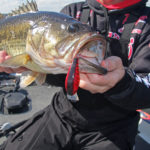
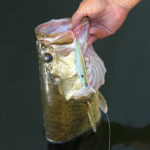
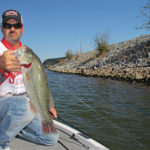
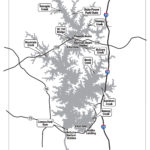



Be the first to comment